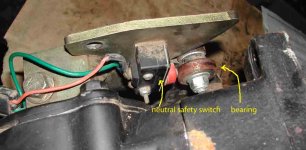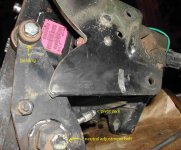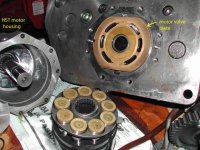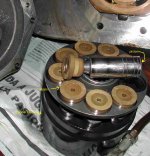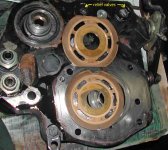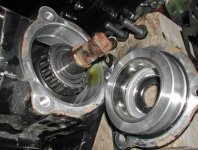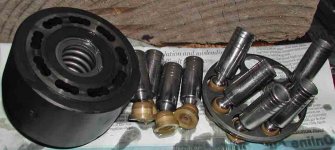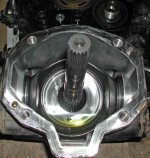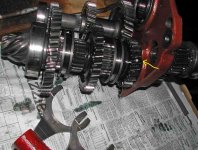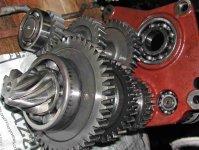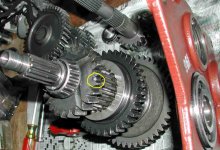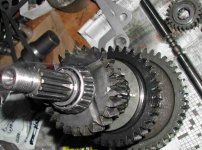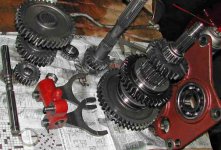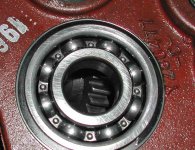First a little more in the HST control, then I will open up the HST.
The first photo shows the back of the swash plate control plate, where
the neutral safety switch is located. This switch has been replaced...and
it was done incorrectly. The wires are supposed to be routed thru a hole in
the control plate; I am sure this would reduce the fatigue on the wires.
These switches will fail eventually, and it is very hard to get at with the
tractor all together. The mechanic struggled to bolt the new switch in, and
you can see that he put one bolt in such that it protruded into the path of
control tie rod. The other bolt was too long and it looks like it is touching
the HST pump housing. When the bearing starts to go, the switch will
fail to work.
In the second photo, I have pointed out the critical sealed bearing that
rides in the V-groove of the swashplate control plate. These go bad, too,
but are cheap and not too hard to replace. This bearing, or failure to
adequately grease the control plate pivot (note the long zerk) are very
common causes of HST pedals failing to spring back to neutral. All the
tractor HSTs I have seen use a neutral adjustment bolt arrangement like
this to adjust for no movement in neutral. Since I will remove and clean
the pivot, I will have to reset the neutral.
Next, I have removed the HST motor, which is also known as a fixed
displacement hydraulic piston motor. You can see the main elements....it
is really not too complicated in there. In this motor the swash plate has
a fixed angle, so the displacement is fixed. The HST pump has a variable
displacement, by virtue of the fact that you can vary the swash plate
angle. I will show that later.
Inside the housing of the motor, you can see the swash plate, upon which
the slipper end of the pistons ride. The pistons are pushed out of the
block by oil pressure from the pump, and they act upon the angled swash
plate. This imparts rotary motion to the shaft. There is a large hole in the
end of the slipper so that some of the oil under pressure can squeeze out
and allow the slipper to ride on a thin film of oil. Look closely and you will
see scratches in the slippers....those are put there intentionally to help
spread the oil film.
The other end of the cylinder block acts, under spring pressure, upon the
valve plate, which seems to be composed of a copper/steel laminate. The
plate has some wear, but I do not think I need to replace them. This wear
may be due to towing the dead tractor in gear. Otherwise the needle
bearings and ball bearings are all good, and there is no scoring on the slippers
or swash plate.
If the tractor had been operated with dirty oil or very low oil, it is likely that
you would see a scored swash plate and damaged slippers.
